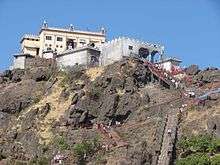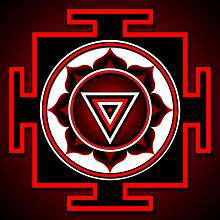Kalika Mata Temple, Pavagadh
Kālikā Mata Temple (or Kalikamata; meaning "the great black Mother")[1] is a Hindu goddess temple complex and pilgrim centre at the summit of Pavagadh Hill in Panchmahal district, India, with in the Champaner-Pavagadh Archaeological Park. It dates from the 10th or 11th centuries. The temple has three images of goddesses: the central image is of Kalika Mata, flanked by Kali on the right and Bahucharamata on the left. On Chitra sud 8, a fair is held at the temple which is attended by thousands of devotees. The temple is the site of one of the Great holy Shakti Peethas. One can reach easily to temple by ropeway.
| Kalika Mata Temple, Pavagadh | |
|---|---|
 Kali Mata Temple with pathway of steps, Gujarat | |
| Religion | |
| Affiliation | Hinduism |
| District | panchmahal |
| Deity | Kalika Mata |
| Festivals | Navaratri |
| Location | |
| Location | Pavagadh Hill |
| State | Gujarat |
| Country | India |
 Location in Gujarat  Kalika Mata Temple, Pavagadh (India) | |
| Geographic coordinates | 22°27′40″N 73°30′42″E |
| Architecture | |
| Type | Nagara architecture |
| Creator | Vishvamitra Rishi |
| Completed | 10-11th centuries |
| Elevation | 800 m (2,625 ft) |
Geography
Kalika Mata Temple is situated in the Indian state of Gujarat, near Halol,[2] at 762 metres (2,500 ft) above sea level.[3] The temple complex is part of the Champaner-Pavagadh Archaeological Park, a UNESCO World Heritage Site.[4] It is set amidst a dense forest cover on a cliff.
The temple can be accessed by a pathway from the road head through the forest over a distance of 5 kilometres (3.1 mi).[3] The path passes the ruins of Patai Raval's palace ruins. Alternatively, there is a ropeway access, which was commissioned in 1986.[5] The ropeway, 740 metres (2,430 ft) in length, is of mono-cable and can carry 1,200 people per hour; it is said to be the country's highest.[6]
History
Dating from the 10th-11th centuries, Kalika Mata is the oldest temple in the area.[3] According to R. K. Trivedi in Fairs and Festivals of Gujarat (1961), the goddess Kalika Mata was initially worshipped by the local [Lewa Patidar and king / sardar is Sadashiv Patel] , until she was later invoked and installed by Vishvamitra on Pavagadh Hill summit, where she is worshipped as a form of Durga or Chandi.There is a legend associated with this temple, Once during the festival of Navratri, the temple had organised a traditional dance called Garba, where hundreds of devotees got together and danced out of devotion towards the Goddess. Seeing such unconditional devotion, Goddess Mahakali herself came amidst the devotees disguised as a local woman and danced with them. Meanwhile, the king of that kingdom Patai Jaisinh who was also dancing with the devotees happened to see the woman and was enchanted with her beauty. Filled with lust, the King held her hand and made an inappropriate proposal. The Goddess warned him thrice to leave her hand and apologize, but the king was too overwhelmed with lust to understand anything. Thus the Goddess cursed that his empire would fall. Soon a Muslim invader Mahmud Begada invaded the kingdom. Patai Jaisinh lost the battle and was killed by Mahmud Begada.[7] Pavagadh's Kalika Mata is also worshipped by the Adivasi.[1] The temple was described in Gangadas Pratap Vilasa Natakam, a 15th-century drama.[8] Named in honor of the Goddess Kali, the temple is believed to be the Kali Mata's residence, and is one of the Shakti Peethas,[9] as the symbolic toe of the goddess Sati is said to have fallen here.[10]
Architecture and fittings
The small and plain temple is set amidst fortifications with an open yard in the front, and is open for long hours to cater to the rush of pilgrims.[3] There are two altars in front of the temple for offering sacrifices to the Goddess, but any kind of animal sacrifice is strictly banned since almost two to three centuries now. The Kali yantra is worshipped at the temple.[11]
The complex is divided into two parts, the ground floor containing Hindu shrines, while the temple spire is domed with a Muslim shrine.[12] The chief shrine on the ground floor contains three divine images: in the centre Kalika Mata in the centre (depicted in the form of a head, known as mukhwato and red in colour[3]), while Mahakali is situated to her right and Bahuchara Mata to her left. The restored marble floor dates to about 1859 and was presented by the minister of Limbdi in Kathiawar. The domed temple spire contains a Muslim shrine and mausoleum to Sadan Shah Pir, a Sufi saint.[12]
Festivals
The temple is one of the biggest tourist and pilgrimage centers in Gujarat, attracting large numbers of people every year.[13][14] It is a Chodhri tradition to make a pilgrimage here at least once in a lifetime.[15] Devotees of Kalika Mata visiting the temple "worshipped by beating bell-metal symbols".[16] A fair is held each year at the temple on Chaitra Sud 8. Especially on the full moon of Chaitra, in April, and at Dasara, in October, there are large meetings of Hindus of all classes.
Travel info
The Temple can be easily accessible by Ropeway. Ropeway facility is for all whether senior citizen or not. This facility helped many tourists as there are too many stairs leading to the temple.
The Temple is situated on a hill with Great pride. The Mahakali Mandir is about 140 km from Ahmedabad, Gujarat. This is the dominant Attraction of the city. The city is also the home of Champaner-Pavagadh Archaeological Park.
References
- Stiglmayr, Elisabeth (1968). Acta ethnologica et linguistica. Universität Wien. Institut für Völkerkunde. pp. 25, 111. Retrieved 28 September 2012.
- Vyas, Rajni (2012). Gujarat Ni Asmita (5th ed.). Ahmedabad: Akshara Publication. p. 26.
- "Pavagadh Hill/Kalika Mata Temple". The Official Website of Gujarat Tourism, Govt. of Gujarat. 22 September 2012. Archived from the original on 12 December 2010. Retrieved 29 September 2012.
- "Champaner-Pavagadh Archaeological Park". UNESCO. Retrieved 29 September 2012.
- "Usha Breco Limited | Maa Kalidevi". Archived from the original on 19 December 2011. Retrieved 29 September 2012.
- Limca Book of Records. Bisleri Beverages Ltd. 1990. Retrieved 28 September 2012.
- Burman, J. J. Roy (2005). Gujarat Unknown: Hindu-Muslim Syncretism and Humanistic Forays. Mittal Publications. pp. 79, 206–. ISBN 978-81-8324-052-9. Retrieved 28 September 2012.
- Śivānanda, Vi; Bhargava, Atul (2009). Champaner Pavagadh. Archaeological Survey of India. p. 33. ISBN 978-81-904866-2-0. Retrieved 28 September 2012.
- Srivastava, Vinod Chandra (2 January 2008). History of Agriculture in India, Up to C. 1200 A.D. Concept Publishing Company. pp. 702–. ISBN 978-81-8069-521-6. Retrieved 29 September 2012.
- "Pavagadh". Government of Gujarat. Retrieved 29 September 2012.
- Bhargava, Gopal K.; Bhatt, Shankarlal C. (2006). Land and people of Indian states and union territories. 33. Daman & Diu. Gyan Publishing House. pp. 170–. ISBN 978-81-7835-389-0. Retrieved 28 September 2012.
- Ruggles, D. Fairchild; Silverman, Helaine (15 June 2009). Intangible Heritage Embodied. Springer. pp. 85–. ISBN 978-1-4419-0071-5. Retrieved 28 September 2012.
- Unesco (30 September 2009). The world's heritage: a complete guide to the most extraordinary places. Collins. p. 730. ISBN 978-92-3-104122-8. Retrieved 28 September 2012.
- Srivastava, Mahesh Chandra Prasad (1978). Mother goddess in Indian art, archaeology & literature. Agam. p. 140. Retrieved 29 September 2012.
- Glatter, Augusta (1969). Contributions to the ethnography of the Chodhris, Surat District, Gujarat. Engelbert Stiglmayr. p. 25. Retrieved 29 September 2012.
- Gujarat State Gazetteers: Kheda. Directorate of Government Print., Stationery and Publications, Gujarat State. 1977. p. 163.
